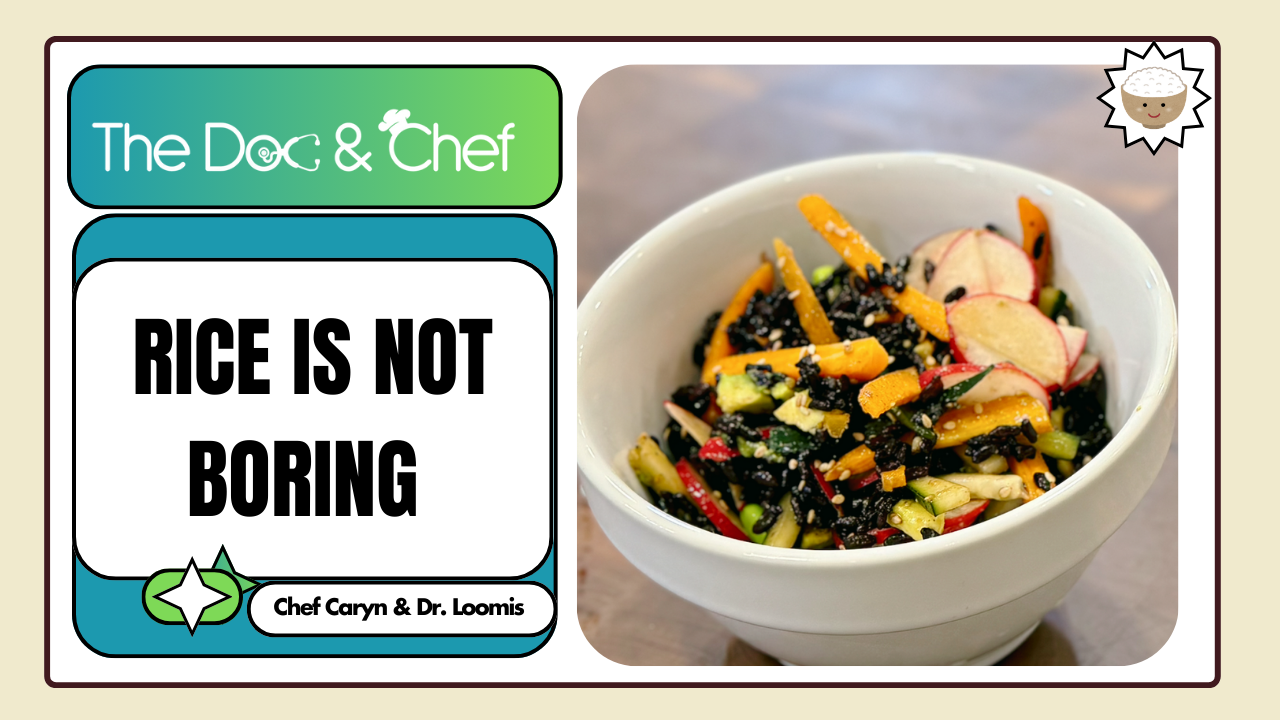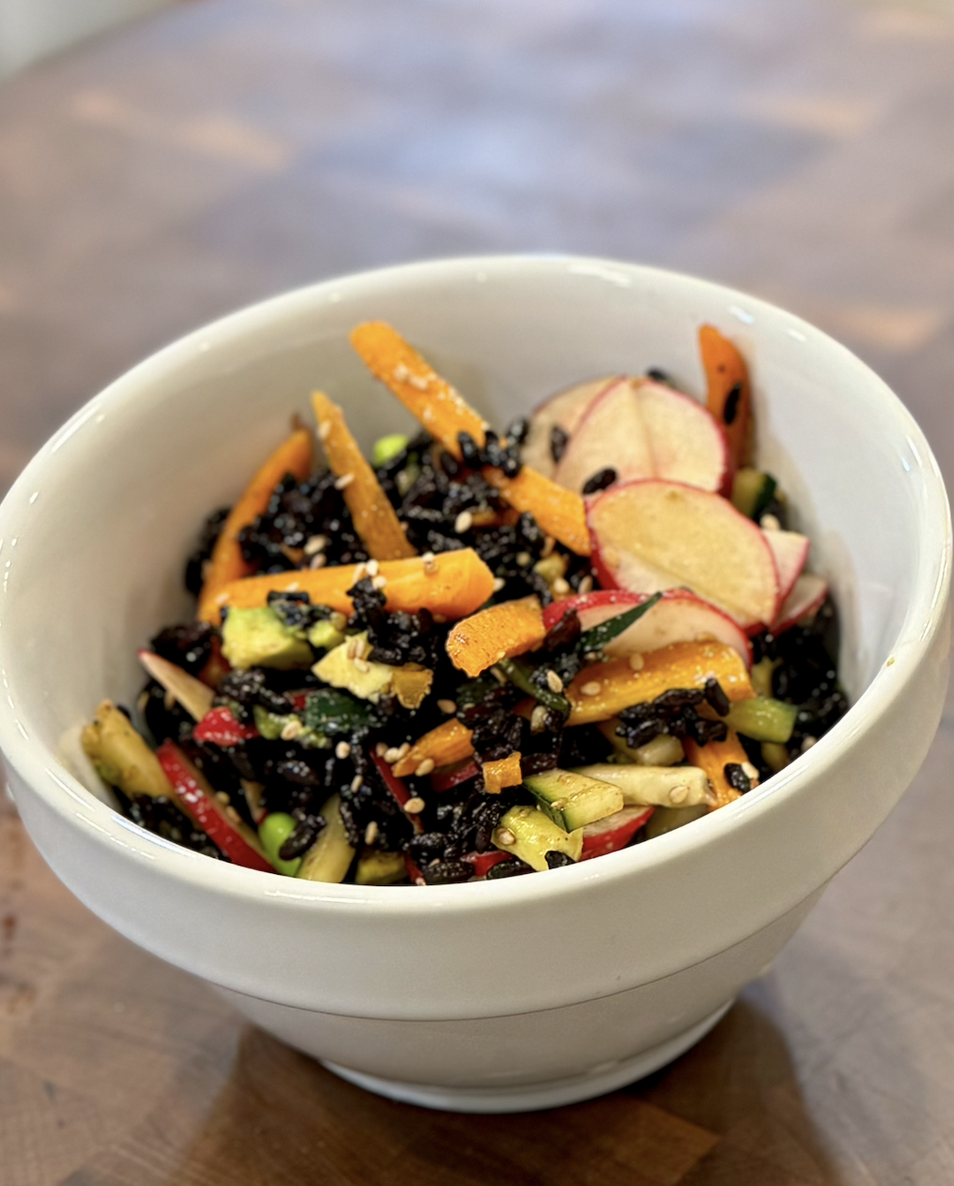THE DOC AND CHEF SHOW EP. 26: RICE // SUPPORTING SCIENCE AND THE RECIPE
Rice is a staple food for a large part of the world's human population. It is a cereal grain, belonging to the grass species Oryza sativa (Asian rice) or Oryza glaberrima (African rice). Rice is believed to have been first domesticated in the region of the Yangtze River valley in China over 9,000 years ago. Another independent center of domestication occurred in West Africa with a different species of rice, Oryza glaberrima, around 3,000 years ago.
A grain of rice has several parts, three of which are edible. The hull, or husk, is the outermost layer, providing protection during growth but inedible and iis removed during milling. Beneath this is the bran layer, which is rich in fiber, vitamins, minerals, and antioxidants, remaining intact in brown rice but removed in white rice production. The main part of the grain is the endosperm, which provides the starchy energy source for the growing seedling and is the main component of white rice. At the base of the grain is the germ or embryo, which contains fats, vitamins, and proteins and has the potential to sprout into a new plant.
Rice comes in numerous varieties, each with its own characteristics in terms of texture, flavor, and culinary uses. The different kinds of rice can broadly be categorized by grain size, color, texture, and nutritional content. Here's an overview of some of the main types[1]:
By Grain Size
● Long-Grain Rice: This type of rice has long, slender grains that cook up fluffy and separate. It's ideal for pilafs or dishes where a less sticky rice is preferred. Basmati and Jasmine rice are popular examples.
● Medium-Grain Rice: These grains are shorter and wider than long-grain rice and tend to be moister and more tender when cooked, with a slightly sticky texture. Arborio rice, used in risotto, is a well-known medium-grain variety.
● Short-Grain Rice: Short-grain rice is almost round and cooks up soft and sticky. It's ideal for sushi, paella, and dishes where the rice needs to clump together.
By Color or Processing
● White Rice: The most common type, where the husk, bran, and germ are removed, leaving mostly the starchy endosperm. It's versatile and can be found in long, medium, and short-grain varieties.
● Brown Rice: Only the husk is removed, retaining the bran and germ, making it more nutritious with a chewier texture and nuttier flavor compared to white rice.
● Black Rice (also known as Forbidden Rice): This rice has a deep black color that turns purple when cooked. It's rich in antioxidants and has a sweet, nutty flavor.
● Red Rice: Like black rice, red rice is rich in antioxidants and has a nutty flavor. Its color ranges from red to maroon.
● Wild Rice: Technically not rice but the seed of an aquatic grass, wild rice has a chewy outer sheath with a tender inner grain and a distinctive nutty flavor.
Specialty and Aromatic Varieties
● Basmati Rice: A long-grain rice from India and Pakistan known for its fragrant aroma and light, fluffy texture when cooked. It's often used in biryanis and pilafs.
● Jasmine Rice: A long-grain rice from Thailand with a slightly sticky texture and a sweet, floral aroma. It's commonly served with Thai and other Southeast Asian dishes.
● Arborio Rice: A medium-grain rice used in Italian risotto. It has a high starch content that gives risotto its creamy texture.
● Glutinous Rice (Sticky Rice): A type of rice that becomes very sticky when cooked. It's used in many Asian dishes, including desserts and sushi.
● Parboiled Rice (Converted Rice): Rice that has been partially boiled in the husk. This process increases its nutrient content and changes its texture, making it firmer and less sticky.
These categories offer a glimpse into the vast world of rice varieties, each with unique characteristics suited to different dishes and culinary traditions.
HEALTH BENEFITS
The nutritional content and health benefits of different kinds of rice can vary significantly based on their type (whole grain vs. refined), processing, and specific variety. Here’s a broad overview comparing various types of rice and their respective health impacts:
Brown Rice (Whole Grain) [2]
● Nutrition: High in fiber, vitamins (B vitamins), minerals (magnesium, phosphorus, selenium), and antioxidants. It contains more protein compared to white rice.
● Health Benefits: High fiber, which supports heart health, aids in digestion, helps in managing weight, and has a lower glycemic index, beneficial for blood sugar control.
White Rice (Refined)
● Nutrition: Lower in fiber, vitamins, and minerals due to the removal of the bran and germ during processing. Often enriched with vitamins (like B vitamins) and minerals (like iron) to compensate for losses.
● Health Benefits: Easier to digest and a quick source of energy, but its higher glycemic index can lead to faster spikes in blood sugar levels. Regular consumption of white rice, especially in large quantities, has been linked to an increased risk of developing type 2 diabetes.[3]
Basmati and Jasmine Rice (Aromatic Varieties)
● Nutrition: Like other white rice when refined, and brown rice when whole. They might have slightly different nutrient profiles due to their specific varieties.
● Health Benefits: The whole grain versions share similar benefits with brown rice, including lower glycemic index and higher fiber content. The white versions provide quick energy but lack the fiber and some nutrients found in their whole grain counterparts.
Black Rice (Forbidden Rice) [4]
● Nutrition: High in antioxidants, especially anthocyanin, which gives it the black color. Also, it contains more fiber and protein than white rice.
● Health Benefits: The antioxidants help protect against heart disease, cancer, and other diseases. Its high fiber content benefits digestion and blood sugar control.
Red Rice [5]
● Nutrition: Similar to brown and black rice, red rice is high in fiber, antioxidants, and nutrients due to its colored outer layer.
● Health Benefits: Antioxidant properties help fight inflammation and may lower the risk of chronic diseases. The fiber content supports digestive health and helps in managing blood sugar levels.
Parboiled (Converted) Rice [6]
● Nutrition: The parboiling process can increase the nutrient content compared to regular white rice, as some of the nutrients from the bran soak into the grain. It's higher in certain vitamins and minerals than standard white rice.
● Health Benefits: Offers a lower glycemic index than regular white rice, making it a better option for blood sugar control. It also provides a modest amount of fiber for digestive health.
Wild Rice [7]
● Nutrition: Not a true rice, but a grass. It's higher in protein and fiber than both white and brown rice and rich in antioxidants, vitamins, and minerals.
● Health Benefits: Supports heart health, aids in weight management, and may have a lower impact on blood sugar levels. It also contributes to a varied diet with its distinct nutritional profile.
HEALTH RISKS
Rice absorbs arsenic from the soil and water where it is cultivated, resulting in varying arsenic levels in different types and origins of rice, which can pose a health risk in people consuming a rice-based diet.
Geographical location plays a significant role in this, with rice from areas where arsenic is naturally present in high concentrations in soil or groundwater, such as certain regions in the United States (notably Arkansas, Louisiana, and Texas) and parts of Asia, tending to have higher arsenic levels.
Brown rice generally contains more arsenic than white rice because the bran layer, which is removed to make white rice, retains more arsenic. Some varieties, like basmati and jasmine rice, are often found to have lower levels of arsenic compared to other types, while wild rice, not technically rice but a different species, usually has lower arsenic levels. Organic rice is not necessarily lower in arsenic, as arsenic is a naturally occurring element that can affect both organic and conventional crops. [8] However, the arsenic content of rice can be significantly reduced by washing and cooking the rice with clean water that is low in arsenic. [9]
SUMMARY
Rice comes in various types, each offering distinct health benefits. Brown rice retains the bran and germ layers, making it rich in fiber, vitamins, and minerals, which help regulate digestion and support heart health. White rice, while more processed and less nutritious than brown rice, provides a quick source of energy due to its high carbohydrate content. Basmati and jasmine rice, often prized for their aroma and flavor, have a relatively lower glycemic index compared to other white rice varieties, which can be beneficial for blood sugar management. Wild rice, not technically rice but a different species, is nutrient-dense and high in protein, fiber, and antioxidants, supporting overall health. Integrating a variety of rice types into a balanced diet can help harness their unique health benefits.
[1] https://www.seriouseats.com/guide-to-rice[2] J Nutr Sci Vitaminol (Tokyo). 2019;65(Supplement):S26-S28[3] Diabetes Care. 2020 Nov;43(11):2643-2650.[4] Front Genet. 2020 Mar 13;11:229[5] Front Genet. 2020 Mar 13;11:229[6] Eur J Nutr. 2022 Mar;61(2):615-624.[7] Crit Rev Food Sci Nutr. 1981;15(3):281-319.[8] Curr Environ Health Rep. 2019 Dec;6(4):361-372.[9] Food Chemistry, Volume 105, Issue 4, 2007, Pages 1718-1725Vegan Black Rice Sushi Bowl
Ingredients:
1 cup black rice
2 cups water
1 avocado, sliced
1 small cucumber, julienned
1 carrot, julienned
1/2 cup edamame, shelled and cooked
1/2 cup radishes, thinly sliced
1 sheet nori, cut into strips
2 tablespoons sesame seeds
Soy sauce or tamari, for serving
Wasabi and pickled ginger, for serving
Dressing:
2 tablespoons rice vinegar
1 tablespoon soy sauce or tamari
1 teaspoon maple syrup or agave nectar
1 teaspoon sesame oil (optional, can omit for oil-free)
1 teaspoon grated ginger
Instructions:
Cook the Black Rice: Rinse the black rice thoroughly. In a pot, combine the rice and water, bring to a boil, then reduce heat to low, cover, and simmer for 30-35 minutes until tender. Let it cool slightly.
Prepare the Vegetables and Toppings: While the rice is cooking, prepare the avocado, cucumber, carrot, edamame, and radishes. Arrange them beautifully for visual appeal.
Make the Dressing: Whisk together the rice vinegar, soy sauce, maple syrup, sesame oil (if using), and grated ginger.
Assemble the Sushi Bowl: In serving bowls, place a base of black rice. Arrange the prepared vegetables and nori strips on top. Sprinkle with sesame seeds.
Serve: Offer soy sauce, wasabi, and pickled ginger on the side. Drizzle the dressing over the bowls before serving.
TIP: Enhancing the dressing for the Vegan Black Rice Sushi Bowl can add depth and complexity to the flavors. Here are some ingredients you can add to the existing dressing to elevate it further:
Enhanced Dressing Ingredients
Miso Paste: Add a teaspoon of white or light miso paste for a deeper umami flavor. Miso also adds a slight creaminess and richness to the dressing.
Lime Juice: Incorporate a squeeze of fresh lime juice for an extra zesty kick, complementing the existing flavors with its bright acidity.
Toasted Sesame Oil: If you're okay with a bit of oil, a few drops of toasted sesame oil can add a nutty and aromatic flavor to the dressing.
Chili Flakes or Sriracha: For a spicy touch, add a pinch of chili flakes or a small squirt of Sriracha sauce. This will introduce a pleasant heat that can enhance the overall taste.
Fresh Herbs: Finely chopped cilantro or shiso leaves can add a fresh, herbaceous element to the dressing, giving it a unique flavor profile.
Garlic: A minced garlic clove or a bit of garlic powder can add a pungent depth, enhancing the savory notes of the dressing.
Yuzu Juice: If available, yuzu juice can add a unique citrus flavor, different from lemon or lime, providing a distinctively Japanese taste.
Join our community and become a member!
Our membership is built like a streaming service - you get a full library of plant-based cooking classes to watch whenever you want. PLUS, you gain access to upcoming interactive virtual cooking classes and a monthly accountability group call.
As a member you get:
Complete library of all past virtual classes - stream them whenever you’d like!
Free access to upcoming virtual classes
Library of easy and quick recipes: 100 and growing
Access to private Facebook group
Monthly accountability check-in and support group Zoom call with Caryn
Quarterly “Ask the Doc” call with Dr. Jim Loomis, our Medical Director
A community of support
To learn more, please visit us here.



